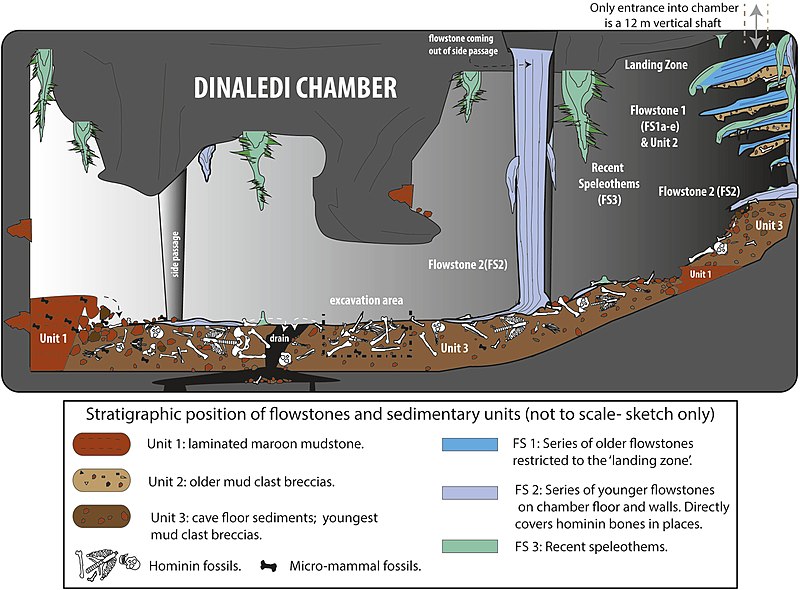
Deep inside a South African cave called Rising Star, scientists have made an incredible discovery—a species of ancient humans that appears to have buried their dead in shallow graves.
“The creatures, named Homo naledi, were short, with long arms, curved fingers, and a brain about one-third the size of a modern human’s,” the New York Times reported earlier this month.
The article lays out an astonishing story of how these burials may have taken place. The ancient human-like species lit fires to illuminate their way down the cave, perhaps forging crude torches out of glowing coals. They littered the area with bits of charcoal, burned bones of turtles and rabbits, and marked soot engravings onto the cave walls near the site of the fossils. They brought wood or some other fuel into the caves with them so they could make fires.
“They might have cooked the animals as a meal, or perhaps as a ritual,” the New York Times reported. “Based on the growing number of fossils scientists are finding in Rising Star…it looks as if Homo naledi may have visited the cave for perhaps hundreds of generations, moving together into the dark depths to bury their dead and mark the place with art.”
In research published in 2015, these same scientists suggested that Homo naledi brought the bodies deliberately to the cave and, rather than burying them, left them on the cave floor, an act archaeologists call funerary caching. “At first, the scientists thought the fossils were spread out evenly across the chamber floors,” the New York Times article reported. “But as they dug up more sediment in 2018, they observed that two fairly complete skeletons rested inside oval depressions.”
These depressions turned out to be the key to the current theory about burial practices. An orange layer of mud surrounded the oval depressions but was not found inside of them, and the break along the edges of the depressions looked clean. This helped to dismiss a theory that suggested that the skeletons had formed the depressions by sinking into the sediment and added further evidence to the claim that they were indeed buried.
In total, scientists have found more than 1,500 fossils of the ancient human-like species in the cave system. The researchers believe these bones belong to at least 27 different individuals.
Dr. Lee Berger, a paleoanthropologist at the University of Witwatersrand in Johannesburg and the leader of the project told the New York Times that the discovery that a small-brained human-like creature did such human-like things was profound and suggested that big brains are not essential for sophisticated kinds of thinking, such as making symbols, cooperating on dangerous expeditions or even recognizing death. Dr. Berger and his colleagues said they don’t believe the bones could have simply washed into the deep recesses of the cave. But there are critics of this explosive theory, many of them in fact.
Homo naledi lived around the time the first humans, a group known as Homo sapiens that includes all of us, were roaming Africa. Around two million years ago, researchers believe that the lineages split, and Homo sapiens developed big brains, and Homo naledi did not.
However, until this discovery, the earliest known human graves were thought to have been dug around 78,000 years ago. Homo naledi is thought to have lived much earlier than that, anywhere from 240,000 years ago to 500,000 years ago. The issue that some researchers cannot seem to wrap their heads around is just how Homo naledi may have orchestrated the complex operation that a set of burials would have involved. You see, in the world of archeology, burials and the ceremonies that surround them are regarded as sophisticated signs of advanced culture. And the issue here is, how could a species have carried out such a sophisticated act, which likely would have required the use of language to arrange and plan, but have such seemingly tiny brains?
“If the researchers are right, the findings will challenge some of the most important assumptions about human evolution,” the New York Times story points out. “Humans and Neanderthals have huge brains compared with those of earlier hominins, and paleoanthropologists have long assumed that the bigger size brought major benefits,” despite coming with their own set of problems too, like “they require a lot of extra calories to fuel, and an infants’ large heads put mothers at risk of dying during childbirth.”
But Dr. Berger’s work and his recent discovery certainly has its critics. A number of experts on ancient engravings and burials said that the evidence did not yet support the extraordinary conclusions about Homo naledi. These critics say that the scene found in the South African cave could have a range of other explanations. For example, the skeletons might have been merely left on the cave floor. And the charcoal and engravings found in the cave might have been left by modern humans who entered long after Homo naledi became extinct.
Dr. María Martinón-Torres, the director of Spain’s National Research Center on Human Evolution, believes the ritual observed in the caves was funerary caching and not necessarily formal burials. She pointed out that the oval depressions did not contain full skeletons in complete alignment, and that Homo naledi may have simply brought the bodies into the cave and then left them on the cave floor, and the bones could have become separated as the bodies decomposed. Paul Pettitt, an archaeologist at Durham University in England, suggested that the bodies might have washed in.
The discovery and the debate connected to it highlight a number of issues that have long been important to Digital Dying. Just what does the manner in which a species or culture treats its dead say about its level of sophistication and intelligence? What are the earliest known examples of different forms of burial practices in the archaeological record? And might the way the dead are treated actually be one of the primary indicators of cultural sophistication?
For example, back in 2011, we wrote about Dorothy the Chimp. After her mother was killed by hunters, Dorothy was sold to an amusement park in Cameroon, where she was chained to the ground and taught to drink beer and smoke cigarettes for noisy crowds. After a rollercoaster life, she ended up at a well-run chimpanzee rescue center in Cameroon, the Sanaga-Yong Chimpanzee Rescue Center. Here Dorothy was rehabilitated. She became a favorite at the center and even mothered a child of her own. In September 2008, she died of congestive heart failure. A burial was arranged by the humans at the chimpanzee rescue center, and the staff let her chimpanzee family watch on, and witness the burial. What resulted was a photograph that went absolutely viral, and was published in the November 2009 issue of National Geographic. It shows Dorothy under a light blue sheet in a wheelbarrow being pushed to the burial site by a park worker. Another worker holds Dorothy’s head gently in her hands. Behind a fence in the background are more than a dozen chimpanzees, staring intently in unison, and looking visibly sad. If these close cousins of ours can appreciate a burial ceremony, and take time out of their busy day of being chimpanzees to stop and pay their respects, then how many steps further is it actually to dig the hole and set up the burial yourselves?
Back at the Rising Star cave in South Africa, another aspect of making incredible archaeological discoveries comes to light. At one point, Dr. Lee Berger, the paleoanthropologist at the University of Witwatersrand in Johannesburg who is credited with the discovery, decided that he wanted to take a look for himself at one of the chambers, known as Dinaledi, that contained the purported grave. He had to lose 55 pounds before he could fit through the narrow passageway, which would take him to the chamber where the discoveries were made. He managed to make it down there but, on the way out, tore his rotator cuff.
“I almost died,” said Dr. Berger, rather dramatically. But he didn’t, and his controversial discovery has now been broadcast to the world.









